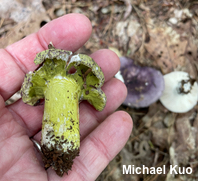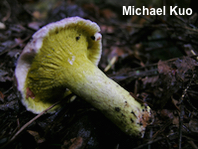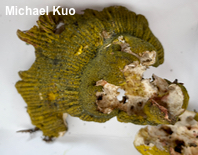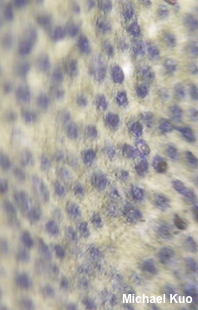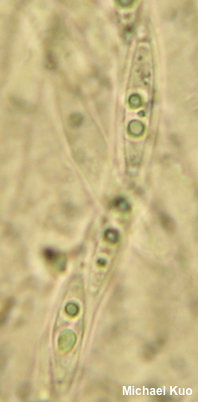| Major Groups > Oddballs & Misfits / Mycotrophs > Hypomyces > Hypomyces luteovirens |

|
[ Ascomycota > Sordariomycetes > Hypocreales > Hypocreaceae > Hypomyces . . . ] Hypomyces luteovirens by Michael Kuo, 6 September 2023 This species of Hypomyces is a parasite on various species of Russula—especially the purple and red species. The fungus is easily recognized by its bright yellow-green color and its habitat, and it seems a little less dedicated to its parasitism than some species of Hypomyces, usually covering only the upper stem and gills of the host mushroom, leaving it fairly recognizable. Description: Ecology: Parasitic on species of Russula—especially the purple and red species; summer and fall, or over winter in warm climates; originally described from Sweden (Fries 1817); widespread in Europe and North America; also reported from India and South Korea. The described and illustrated collections are from Kentucky, Ohio, and Pennsylvania. Fruiting Body: A powdery, bright yellow-green, mold-like covering that progresses over the stem and gills of the host (and sometimes over the cap surface); with old age the fungus darkens to olive green or greenish brown. Perithecia: Dark green to black; embedded; usually barely visible to the naked eye. Chemical Reactions: KOH on surface promptly black. Microscopic Features: Spores 30–36 x 4.5–5.5 µm at maturity; fusiform; smooth at first, becoming verrucose; developing apiculi that narrow to a point; hyaline in water and KOH; not septate. Asci 150–200 x 5–7.5 µml cylindric; 8-spored. Subicular hyphae 2–5 µm wide, septate, smooth, greenish in KOH; terminal cells subclavate. REFERENCES: (E. M. Fries, 1817) L. R. Tulasne & C. Tulasne, 1860. (States, 1990; Phillips, 1991/2005; Schalkwijk-Barendsen, 1991; Lincoff, 1992; Metzler & Metzler, 1992; Rogerson & Samuels, 1994; McNeil, 2006; Miller & Miller, 2006; Trudell & Ammirati, 2009; Das & Chakraborty, 2013; Beug et al., 2014; Kuo & Methven, 2014; Evenson, 2015; Woehrel & Light, 2017; Baroni, 2017; Kim et al., 2017; Elliott & Stephenson, 2018; Læssøe & Petersen, 2019; McKnight et al., 2021.) Herb. Kuo 10010414. This website contains no information about the edibility or toxicity of mushrooms. |
© MushroomExpert.Com |
|
Cite this page as: Kuo, M. (2023, September). Hypomyces luteovirens. Retrieved from the MushroomExpert.Com Web site: http://www.mushroomexpert.com/hypomyces_luteovirens.html |
